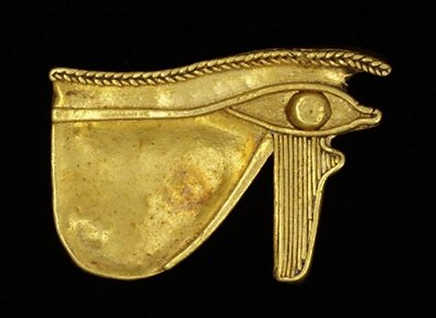Amulets

Spotlight

Spotlight #1 – Convulsion key
Fraisschlüssel from Fraisketten in the Diözesanmuseum, Freising (Bavaria, Germany). Inv. H211. Two keys in two views each. A and B: Key with IAZR stamped on one side and 1698 on the other; C and D: Key with MAZR 1757 stamped on one side and ACZR 1729 on the other. E: Key on H210 (Source: author’s photograph).
This image shows several brass keys. They are clearly decorative rather than functional to open a lock. The inscriptions on the keys give clues as to their provenance. I A Z R is an acrostic for Iacobus Abt Zu Rein and refers to Jakob Zwigott (1643/4-1709) who presided as the 41st Abbot of Rein Abbey (Stift Rein), a Cistercian Monastery in Styria, a state in south eastern Austria. The monastery was originally founded in 1129. The date on the obverse side of the key – 1698 – marks the year of his appointment to the post and suggests that the object might have been produced to commemorate his inauguration. This, and the other keys in the figure, are all examples of Reiner Gnadenschlüssel – ‘Mercy Keys’ or ‘Grace keys’ from Rein Abbey. As the name suggests, the keys were believed to be carriers of divine blessing. They were given to pilgrims who visited the monastery at times of special celebration and particularly on ‘White Sunday’ – the first Sunday after Easter. Today, this festival is often referred to as the ‘Reiner Schlüsselfest’.
But what about the amuletic status of the keys? In addition to being grace-carrying pilgrimage souvenirs they were believed by many to possess healing properties, particularly in relation to children. This is especially obvious in the examples in the accompanying photograph. These keys have all been incorporated onto polyamuletic rosary-like chains or necklaces from the Austro-Bavarian region and known as Fraisketten – ‘convulsion chains’. Frais is an ancient German term which refers to all types of cramps, spasms, fits, convulsions and seizures (especially epileptic) experienced during childhood. Many different types of amulet were collected together on the chains which were hung either around the neck of the young child, or over the bedstead in order to provide synergistic protection through the night; being combined onto a single chain their protective power would be mutually enhancing. Indeed, the keys are sometimes referred to as Fraisschlüssel – Frais or convulsion keys – reflecting its application as a therapeutic and prophylactic amulet against the condition.
Further Reading:
Duffin, C.J. (2021): Convulsion Chains. Jewellery History Today, Issue No. 41 (Spring 2021): 6-7.
Duffin, C.J. (2023): Convulsion Keys: Folk medicine amulets of the Austro-Bavarian region. Pharmaceutical Historian, 53 (3): 79-83.
Both papers are available here: https://www.researchgate.net/profile/Christopher_Duffin
Christopher J. Duffin
1 December 2023
Spotlight #2 – Cimaruta
The cimaruta is an exclusively Italian folk amulet. Always made of silver, it takes the rather stylised form of a sprig of the medicinal herb, Rue (Ruta graveolens). This medicinal, culinary and ornamental perennial shrub has been known as the Herb of Grace since at least Shakespeare’s time. Historically, it was believed to offer protection against evil influences and rue brushes were used to sprinkle holy water during the Catholic Mass. William Coles (1626-1662) was an Oxford graduate with a particular interest in botany (and acclaimed as ‘the most famous simpler or herbalist of his time’). According to Coles, the Paracelisan Oswald Croll, who served at the court of Philip II in Prague, commented on the form of the seeds of the plant; they were adorned with the sign of the cross and thus ‘driveth away all Phantasms, and evill Spirits, by Signature’. This latter comment refers to the Doctrine of Signatures which held that God placed identifying marks, forms, colours etc in the natural world to act as identification markers for items of potential therapeutic use to mankind.


Italian Cimaruta on display at the Pharmaziemuseum der Universität Basel (Source: author’s photograph).
The Neapolitan term cima di ruta literally means ‘sprig of Rue’. In the cimaruta, the branching sprig forms the base from which a number of other figures are hung, the whole fused together to form a complex amulet. The Rue flowers are sometimes depicted in side view, as in the accompanying example, and sometimes looking directly into the flower itself. The specimen in the Pharmaziemuseum of Basel University has four amulets attached to the ends of the branches of Rue – a fish, a key, a flower and a depiction of a half moon.
A complete plant, in flower, of Rue (Source: Wikipedia).
Other examples include attached amulets of manofica, horn, sword, dagger, plumed helmet, cock, heart, dolphin, eagle, owl, serpent, cornucopia and cherub. The manofica mentioned above is a gesture where the thumb is inserted between the index finger and the second finger. The gesture was commonly used to ward off the Evil Eye.
Most of the elements have been interpreted as being related to the cult of the Roman and hellenistic goddess of the moon and patroness of childbirth, Diana (see further reading). The cimaruta was worn by children as a means of protection against the Evil Eye. This was necessary because infants were believed to be especially susceptible to the forces of malocchio being projected upon them by a jettatore.
Relatively little has been written on cimarute. The main references are given below.
Further Reading:
Elworthy, F.T. 1895. The Evil Eye. An Account of this Ancient and Widespread Superstition. xiv + 471 pp. London: John Murray.
Grimassi, R. 2012. The Cimaruta and other Magical Charms from old Italy. Springfield: Old-Ways Press.
Gunther, R.T. 1905. The Cimaruta: its Structure and Development. Folklore, 16: 132-161.
Neville-Rolfe, E. 1897. Naples in the Nineties: A Sequel to Naples in 1888. x + 322 pp. London: Adam & Charles Black.
Christopher J. Duffin
3 December 2023
Spotlight #3 Eye of Horus

Egyptian amulet in gold with the (right) wedjat eye of the god Horus, circa 300-30 BC (Ptolemaic Period) V& A accession number M.33-1963, bequeathed by E. H. Wallis in 2007 (Source: Copyright V&A Collections).

Inlay Depicting "Horus of Gold", Egyptian (Late Period to Ptolemaic Period; 4th century BC. Metropolitan Museum of Art Accession number: 26.7.996. Purchase, Edward S. Harkness Gift, 1926. (Source: Metropolitan Museum of Art, Public Domain)
Further Reading:
Andrews, C. 1998. Amulets of Ancient Egypt. 112 pp. Bath: The Bath Press.
Christopher J. Duffin,February 2024
The wedjat or udjat eye is a very common Egyptian symbol used from later Old Kingdom times (circa 2300 BC) until the Roman Period (30 BC to AD 641). The figure comprises the shape of a human eye with a stylised brow above it (the herringbone goldwork in the figure). The eye is usually embellished with a drop-like shape descending from the central base of the lower eyelid and an uncurling spiral figure descending from the back portion of the lower lid, as in the image. The line of the upper eyelid is also extended backwards. Amulets representing both the right and the left eye are known and there is enormous variety in both the complexity of the figure, and the material used. Examples are known fashioned in gold (as in the figure), various rock types (e.g. lapis lazuli, diorite, obsidian, porphyry), minerals (feldspar, amethyst, sard, carnelian, chalcedony, haematite, agate, steatite, serpentine) and man-made materials (glass, faience).
The overall form of the amulet evokes not only the shape of the human eye but also that of the falcon, the bird in whose form the god Horus is most commonly depicted. Horus was the son of the important goddess, Isis, and Osiris, the god of fertility and the afterlife. According to Egyptian mythology, Isis gave birth to Horus after Osiris had been murdered by Set (the god of disorder and violence), her jealous brother, and dismembered. It was believed that, as the god of kingship, healing, protection, the sun and the sky, that the Sun was Horus’ right eye and the Moon his left eye; they crossed the sky when Horus flew across it in the form of the falcon.
According to the ‘Contendings of Horus and Seth’ recorded in the Chester Beatty Papyri, Horus and Set fought an 80-year long series of battles to determine who should be Osiris’s royal successor. One component of their conflict saw Set removing, depending on the account either one or both of Horus’s eyeballs while he slept, and tearing them to pieces. This resulted in the periodic waxing and waning of the moon. Thankfully, Horus was healed by Thoth, the Moon god, who restored his vision. The waning moon recorded the injury to the eye, and the waxing moon its restoration. The eye of Horus was thenceforth referred to as wedjat, meaning ‘whole one’. Wedjat amulets could be worn on the individual and were commonly included in the wrappings around mummies. They were believed to be strong and effective elements of protection, both for the living individual and the soul as it made its hazardous journey into the afterlife. Even more effective than single eyes, amulets containing multiple representations of the eye of Horus were believed to act synergistically to multiply their benefits.